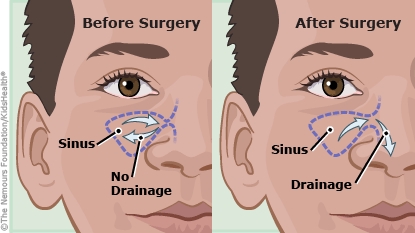Sinuses are air spaces in the bones of the face around the nose. The sinuses can get clogged from mucus or polyps (harmless growths). This can lead to sinusitis (swelling and irritation of the sinuses). Your child had functional endoscopic sinus surgery (FESS) to open the sinuses. They may have pain, black eyes, a swollen nose, or small nosebleeds for a few days. They will also have nasal stuffiness (congestion), which will slowly feel better over a few weeks.


Follow your health care provider's recommendations for:
At home:

Your child:

Your child:

Why is FESS done? Sometimes, the sinuses become very narrow and clogged with mucus because of infections, swelling, or growths (polyps) in the lining of the sinuses. FESS helps open the sinuses so air and mucus can flow through them again.
How is FESS done? The surgeon put a thin tool called an endoscope through your child's nose into the sinuses. The endoscope lights the inside of the sinuses and enlarges the view. The surgeon used gentle suction to clean out mucus or pus, and took out any blockage to make the air spaces in the sinuses bigger. Usually, a dressing is placed inside and under the nose to catch any drainage.